
This is the Soldiers Memorial in downtown Saint Louis, Missouri. This is a monument to those who died during the Great War; it contains a military museum, which has artifacts from all of the wars, including Iraq. It was dedicated by President Franklin Delano Roosevelt in 1936 and opened to the public on Memorial Day, 1938.
The inscription over the entrance reads "TO OUR SOLDIER DEAD".
This building is in the Art Deco style; with flattened and stripped-down Classical elements, as well as some streamlining. The building exterior and sculpture are primarily limestone with granite foundations and stairs.
It was designed by the firm of Mauran, Russell & Crowell, who also designed numerous other distinctive buildings in downtown Saint Louis, including the Federal Reserve Bank, AT&T building, and also the U.S. Court House and Custom House, which also has the 'flattened classical' Art Deco style like the Memorial. Members of this firm were educated at the Massachusetts Institute of Technology and l'École des Beaux Arts in Paris. See article on architect John Lawrence Mauran.
Some sculpture here was done by Hillis Arnold (1906-1988), who also made a statue of Mary at nearby Fontbonne University, the tabernacle at Saint Anselm Parish, and a sculpture at the pre-Vatican II Modernist church Resurrection of Our Lord (reformed in 2005 as the Vietnamese language parish) in Saint Louis. Having lost his hearing as an infant, his mother encouraged his artistic ability; he taught sculpture and ceramics for thirty-four years at Monticello College in Illinois. He is primarily known as a religious sculptor, and advocated Symbolism, an artistic movement involving spirituality, imagination, psychology, and dreams, and Expressionism, where an artist expresses emotion in his work, especially anxiety.
Arnold also sculpted the World War II memorial located in front of this building.
A monument across the street from the memorial commemorates the place where the American Legion was founded in 1919.

These super-heroic figures flanking the entrances were done by Walker Hancock (1901-1998). Here is a Greek warrior with the winged horse Pegasus. During an interview in 1977 the artist said:
Well, I can tell you, at some length, if you don't mind, about one of my early experiences, my largest early experience, which was the St. Louis Soldiers' Memorial. The architect came to me with a design for a building, done in the style of the day, which was a kind of Art Deco, but a very ponderous architectural mass. Very good, I think for its kind. And they said, "Now we want winged horses on both sides of these entrances. What do winged horses mean?" And I said, "Well, the only winged horse that I know of was Pegasus, and that meant poetic inspiration." And they said, "Well, it can't mean that on this building. What can we make a winged horse mean?" And I thought, "Well, if you put figures beside the winged horses you might suggest that they have a certain meaning." So, that idea was agreed upon, and I made the models and they were approved by the architect, the sketch models, then the scale model, and we had finished three, there were to have been four altogether, a male and a female figure on each side of the building. I had reached the last one, which in my sketch was female figure shown bearing a floral offering of some kind, a wreath. And, they said don't bother submitting the scale model, we're in a hurry, just go ahead, it will be approved, everything is all right, and we'll get it out as fast as we can. So I did this figure of the woman, in which I changed what had been in the sketch to a figure of a child. This I had in my studio in New York, at the time I was living in my studio on 20th Street.Hancock received a classical education, and studied at Washington University, and at Paris and Rome. He did a considerable amount of Christian religious sculpture and worked with the noted Anglo-Catholic architect Ralph Adams Cram.
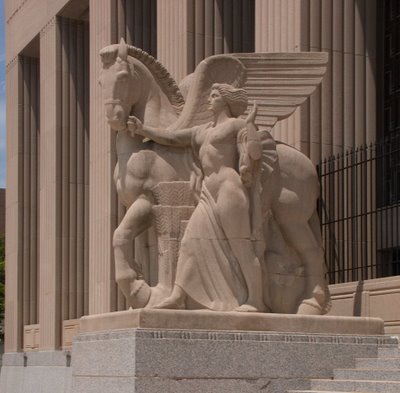
A very muscular woman. This and the previous statue are on the south side of the memorial, symbolizing courage and vision. The statues on the north side symbolize loyalty and sacrifice. These aren't quite classical virtues, and they certainly aren't modern virtues.
These figures look almost like comic-book superheros. This may not be a coincidence: the Golden Age of comic books started in the 1930s, and the various arts and styles were highly entwined. This memorial was dedicated in 1936. Superman appeared in 1938, and Batman in 1939.
Real humans never looked like this, at least until the development of the scientific practice of body sculpting and the use of steroids.

This style of architecture was completely rejected soon after the Second World War in favor of Modernism, for it was associated especially with the architectural works of Albert Speer, who designed numerous buildings and monuments for Nazi Germany.
These superhero sculptures are similar to those done in German between the wars, especially those done for the Berlin Olympics of 1936; and it must be admitted that these sculptures do have uncomfortable connotations, such as paganism and the cult of the body.
However, this style was popular throughout the civilized world: Germany, the United States, Britain, China, and Argentina among others all had this stripped-down Classical style. After the Second World War, Marxist theorists successfully proposed the acceptance of Modernism instead of Classicism, but this Classical style was also popular in the Marxist Soviet Union. Perhaps this could be called the architecture of the rise of "big government".
Most famously, the German Bauhaus style was proposed as the alternative to the Classical tradition: as the theory goes, the Nazis hated the Bauhaus, which supposedly makes it good. Even though the Nazis shut down the Bauhaus, due to its Marxism, its style was wildly successful in that country between the wars, specifically in industrial design, which after all was the primary focus of that school. The German war machine was Bauhaus, even if its government buildings were not.
Ultimately, Modernism proposed the erasing of history. This is why history is no longer taught in the public schools, and why Modern buildings are devoid of any symbolic or historical detail. While it is true that conflicts due to ancient ethnic hatred makes us want to sometimes forget the past, this was a strongly misguided effort. Modernism is associated with the idea of inevitable progress, and so was embraced by both the capitalists and socialists: they think that things are always getting better, and that the past was bad and is best forgotten. However, as any dedicated student of history soon finds out, the same mistakes have been made over and again, and that any notion of 'progress' had better be concrete. Hence we have the concept of a living tradition: we learn from the past and carefully try to improve on it.
The American military officer training schools are well known for their emphasis on science and mathematics, but they also have strong emphasis on history, the humanities, and especially the classics. The American military is an institution that has a great deal of respect for the past.
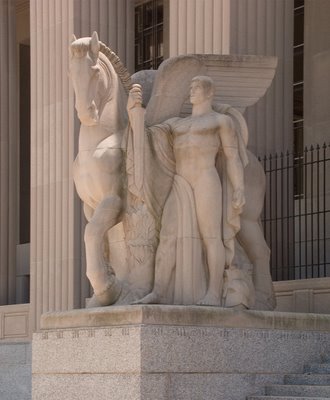
The memorial, as well as many surrounding government buildings, monuments, fountains, and plazas, was funded by a 87 million dollar bond issue approved in 1923; $6 million was set aside for this memorial.
In 1923 the Great War was seen as a horrible disaster, never to be repeated, and was the "war to end all war". This era had pacifist patriotic songs, and those who profited from the war were called "merchants of death". A great memorial to the American soldiers who helped bring this awful war to a quick end was certainly appropriate. There was a great hope for peace, progress, and prosperity in the coming years.
The $6 million was quickly spent buying up the property for the Memorial, and it took ten years to obtain additional funding and start construction.

When the memorial opened in 1938, things had gone horribly wrong, and everyone knew that the peace was soon to end. Opinion was divided over the relative merits of Fascism and Communism, (and what were the alternatives?) but a war would certainly settle the matter.
With the development of air power, it was assumed that any future war would be very quick and decisive. Little did they know that the new war would not be quick, and that the losses were far greater than what was suffered in the First World War. Also in this new war the notion of chivalry was gone, along with the old monarchies who supported it; with the new populist governments in control of Europe, civilian populations were then directly targeted.
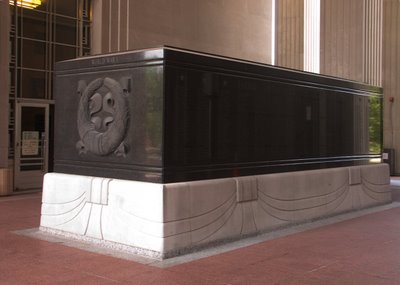
A cenotaph, or empty tomb, made of somber black polished granite, memorializing the 1075 Saint Louisians who lost their life in the Great War. The names are inscribed on the sides.
This is in the loggia, or open-sided center, of the Memorial. Like the Lincoln Memorial in Washington, D.C., this building is based on a Greek temple, entered from the side instead of the end. Ancient Greece was admired because of its democracy; but the lessons of Greek history and its failed democracy were forgotten. Personal greed and lack of virtue ended the independent state of Athens, and by war it became incorporated into a vast empire.
The building is in the form of a Greek temple, and in those Greek temples sacrifices were offered to the gods. The symbolic value of this is quite strong, although it can approach State idolatry: during the Civil War, women were said to "place their husbands and sons on the altar of the Nation", that is, offering them in blood sacrifice. Indeed, the cenotaph is inscribed "THOSE WHO MADE THE SUPREME SACRIFICE".
Sacrifice is not the exception, but the rule, with the sacrifice of Christ on the Cross being its most perfect form. Nowadays we don't like the idea of self-sacrifice; instead we force it on the weak or helpless.
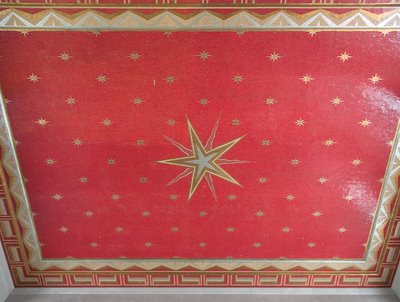
The ceiling of the loggia. The gold mosaic star is dedicated to the mothers of the soldiers.
The red of the ceiling is far stronger that is shown in this photo: for whatever reason, my camera now has difficulty photographing red.
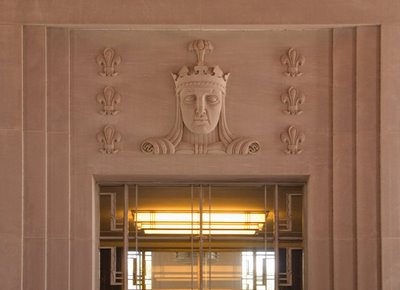
Louis IX, King of France, namesake and principal patron of the city.
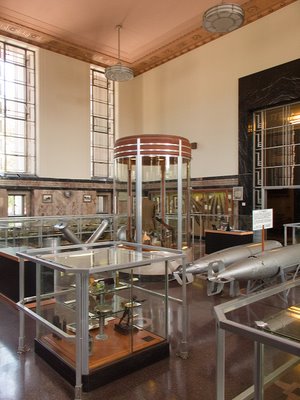
The east and west wings of the building contain a military museum, filled with weapons, uniforms, and various artifacts, including captured spoils of war. The city fortunately has done some recent maintenance and updating of the exhibits. The museum has free admission. There are also some public offices in this building.
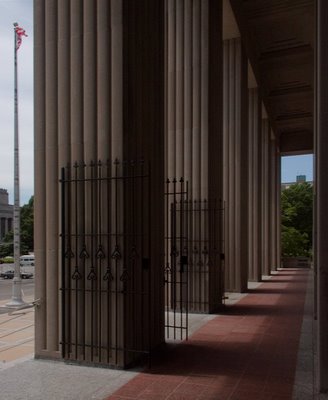
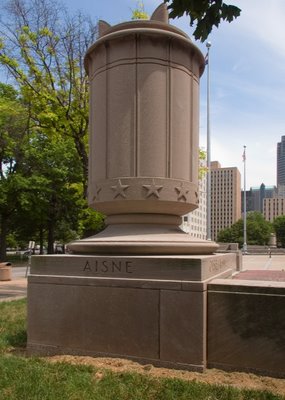
The literature calls this a 'pylon' but that isn't right. These urns are at the four corners of the building, and their bases are inscribed with the names of battles fought by Saint Louisians.
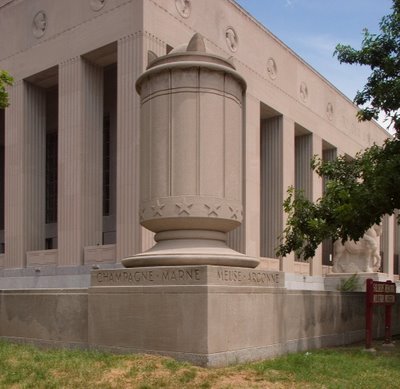
Hours:
9 a.m.-4:30 p.m., daily
Address:
1315 Chestnut Street
St Louis, MO 63103


No comments:
Post a Comment